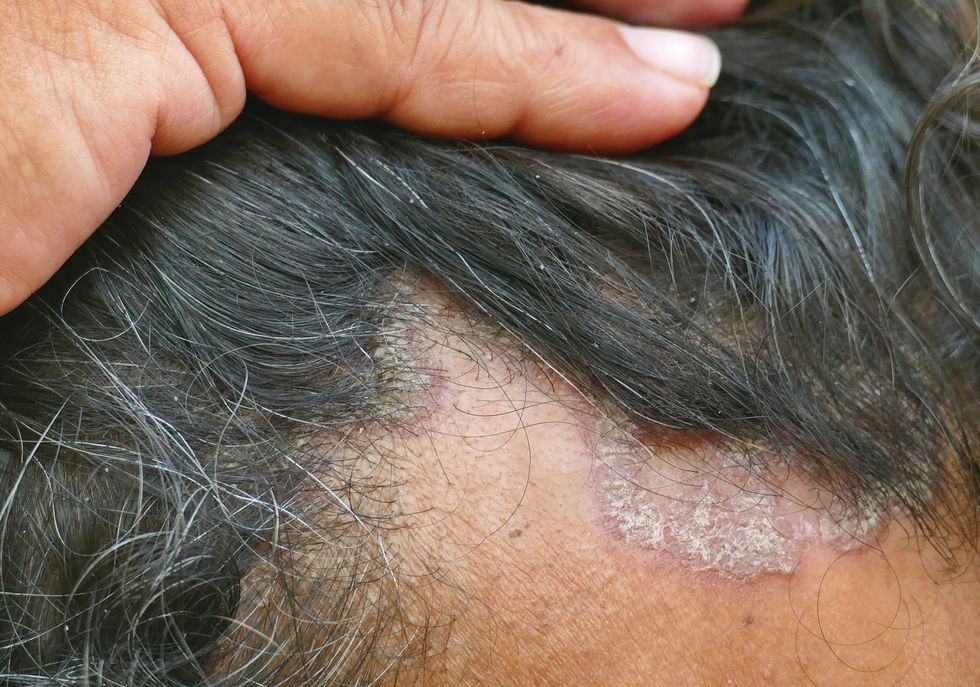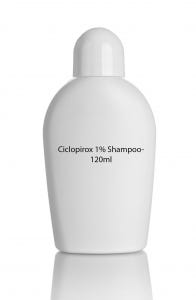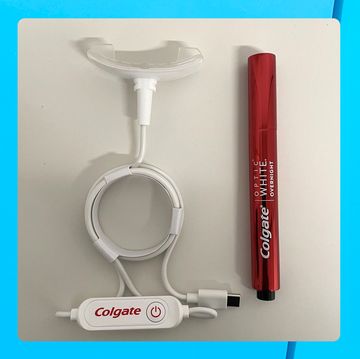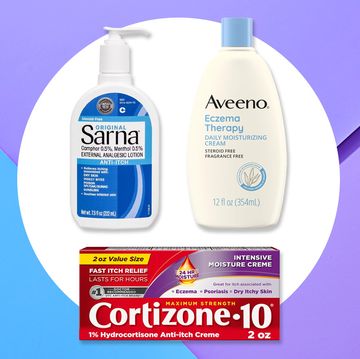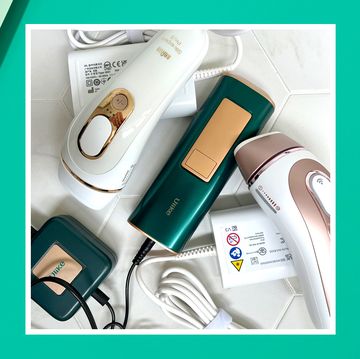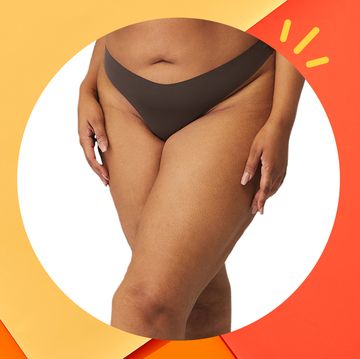Anyone who deals with an itchy scalp knows that sometimes, it can appear out of nowhere, during any time of the year. The experience is never fun, and can cause some panic if it’s new and appeared out of nowhere. But there are many reasons why you're suddenly scratching your head 24/7, and most of them are normal.
Dandruff and fungus, for example, are common, manageable conditions that could be solved with the right shampoo or an OTC med. There are many different causes of an itchy scalp, “including skin conditions such as seborrheic dermatitis, scalp psoriasis, eczema, head lice and reactions to hair products to name a few,” dermatologist Ramya Garlapati, MD, says.
Other causes may be a little more serious. Think: precancerous lesions, allergic reactions, and nerve issues. And while they are still treatable, you may need to seek professional help to clear them up. In many of these cases, “the more you scratch, the worse your condition gets,” says Michele Green, MD, a cosmetic dermatologist based in NYC. So, resist the urge even if you really, really want to.
Whether you're dealing with itching caused by greasy hair or lice you picked up at a weekend getaway, here are tips and tricks to help you get relief.
Meet the experts: Michele S. Green is a cosmetic dermatologist based in NYC. Ife J. Rodney is a dermatologist and dermatopathologist and the founding director of Eternal Dermatology + Aesthetics In Fulton, Maryland. Ramya Garlapati is a dermatologist based in LA.
1. Dandruff
What it looks and feels like: You've got white flakes and itchiness all over your head.
What causes it: Dandruff has three main causes: an oily scalp (not a dry one), a buildup of dead skin or styling products, or a yeast-like fungus called Malassezia.
How to get relief: Vigorously massaging shampoo into your scalp (not just into your hair) may lift product buildup, but if flaking persists, use shampoo containing zinc or salicylic acid, which treats fungus, buildup, and oil, like Head & Shoulders Classic Clean Shampoo ($6) or Nizorol Anti-Dandruff Shampoo ($25). Dr. Green gives Head & Shoulders and Nizorol her gold star of approval, saying they're "the only things on the market that work." Still itching after a few weeks? You may need to visit your derm to see if something else is going on.
2. Allergic Reaction
What it looks and feels like: Your whole scalp feels itchy and either dry or overly greasy. Your hair often gets irritated when you put a lot of product in it, and that can cause you to scratch, per Dr. Green.
What causes it: Ingredients in some hair products can prompt an allergic reaction, says Maria Hordinsky, MD, a professor and the chair of dermatology at the University of Minnesota in Minneapolis. "The allergen is often fragrance or a moisturizing agent called propylene glycol (PG)," she adds.
How to get relief: Stop using these products for a week. If the irritation goes away, replace them with fragrance- or PG-free options (for the latter, try the Alba Botanica shampoo, $18.99). Scorching temps from styling tools like blow-dryers, flat irons, and curling irons can also dry out the scalp and cause itchiness, so keep heat settings on medium. Dr. Green sometimes tells her patients to put olive oil in their hair. "I know that sounds really disgusting, but olive oil will help with the dryness," she says. "It's an old wives tale that actually works!" She also recommends the Keravive Scalp Treatment and frequent hair washing.
3. Psoriasis
What it looks and feels like: Your itch is just in one spot, and you have raised, scaly patches.
What causes it: This is an autoimmune condition and it runs in families, according to the American Academy of Dermatology (AAD). Things like stress, an infection, some medications, and cold, dry weather can trigger flares, though.
How to get relief: If your dermatologist determines you have psoriasis, use a shampoo with coal tar—sounds weird, but it works—like Neutrogena T/Gel Therapeutic Shampoo ($5), says dermatologist Joshua Zeichner, MD, the director of cosmetic and clinical research at Mount Sinai Hospital in New York City. Your doc can prescribe stronger remedies if needed.
4. Precancerous Lesion
What it looks and feels like: A crusty spot about a quarter-inch in diameter. Dr. Green describes precancerous lesions as red, scaly, and itchy patches on your body. Patients may also experience hair loss from the targeted scratching, she explains.
What causes it: It’s called actinic keratosis, and it’s the result of sun exposure over many years, says Dr. Hordinsky.
Next steps: About 10 percent of these actually become cancerous, so see your derm ASAP to have it checked and, if needed, removed. Dr. Green says precancerous lesions can be treated with creams and blue light after a discussion with your dermatologist. Ward off future damage by using a sunscreen specially formulated for the scalp, such as Banana Boat Sport Quik Dri Scalp Spray ($9.99)—yes, in the winter too.
5. Hives
What it looks and feels like: Red, itchy spots where the skin is raised.
What causes it: It’s usually linked to an allergic reaction to something, like your shampoo or a product you used, says board-certified dermatologist Ife J. Rodney, MD, the founding director of Eternal Dermatology + Aesthetics.
How to get relief: “Take an oral antihistamine, like Benadryl or Zyrtec,” Dr. Rodney says. One thing you shouldn’t try is a topical antihistamine cream. “They can make things worse,” she notes.
6. Lice
What it looks and feels like: Lice create an itchy feeling all over your head. You may also see the eggs of the parasites along your hair shaft (they can look like grains of rice), Dr. Rodney says.
What causes it: You get head lice from coming into contact with someone who has it, or from sharing things that they’ve used, like a hat, comb, or brush. Dr. Green advises her patients to watch out for the lice their children or siblings may bring home from school or summer camp.
How to get relief: Permethrin shampoo is usually used to treat lice. While you can find it OTC, you may need a prescription, especially if you have a particularly serious case, Dr. Rodney says.
7. Scabies
What it looks and feels like: It causes really intense, annoying itching, according to Dr. Rodney.
What causes it: Scabies is caused by tiny mites that burrow in your scalp. It isn’t very common, but people who do get the condition usually have had close contact with someone else with scabies. They may have recently stayed at a motel or hotel that was infested, Dr. Rodney says.
How to get relief: “You need to see a dermatologist,” Dr. Rodney says. “Over-the-counter treatments don’t usually clear this up.” Like lice, scabies is usually treated with permethrin, she says.
8. Scalp Ringworm
What it looks and feels like: Dandruff or scaliness, although it could be a round patch with raised borders.
What causes it: The contagious fungal infection is caused by direct contact with an infected person, Dr. Rodney says. Dr. Green adds that a furry friend may also be the culprit: "People who have kittens and things like that are more likely to get a fungus from their pets," she explains. "I know it's crazy, but is your pet's skin healthy?" It's likely that if your pet is also scratching, they may have a fungal infection that you could have picked up.
How to get relief: For more mild cases, an antifungal shampoo may do the trick. Though, if the itching is really bad, a steroid lotion or ointment may be the key to your relief, says Dr. Rodney. In some cases, you’ll need an oral antifungal med, which means you need to call your doctor. Make sure your pet is getting the appropriate treatment too!
9. Atopic Dermatitis
What it looks and feels like: You'll notice itchiness and redness on your scalp. It’s also likely to show up on your elbows and backs of your knees, Dr. Rodney says.
What causes it: It’s usually genetic, so you’re more likely to have it if someone else in your family has the condition.
How to get relief: Try to figure out your triggers, like scented or abrasive shampoos. “It’s super important to take short, warm showers, instead of hot showers,” Dr. Rodney notes. You’ll also want to use a gentle conditioner to moisturize your scalp.
10. Nerve Issues
What it looks and feels like: You won’t see anything on your scalp, except for maybe some scratch marks. “We can always tell when a patient has nerve issues because there’s no primary skin lesion,” Dr. Rodney says.
What causes it: Nerves in your scalp that are overreacting and firing too often. “No one really knows why the nerve roots are irritated or why it feels good to scratch, other than it makes them feel temporarily good and that seems to be psychological almost," Dr. Green says. She also notices that many of her patients with anxiety put finger to skin when they are stressed, which activates the nerves. She calls it a "scratch-itch cycle," which turns vicious when the motion further irritates the area.
While there's no one neurologic condition that does it, any injury of the spinal cord or brain can cause this type of itch, says Dr. Green. If you're experiencing an intensely itchy scalp without signs of a rash or another skin reaction, you may be dealing with neuropathy, according to the American Academy of Dermatology Association (AAD).
An itch is also a symptom of neurodermatitis, which causes dry, itchy patches that can be found anywhere on the body, per Cleveland Clinic.
How to get relief: Meet with your primary care physician and undergo some basic testing to figure out what's going on. Your doctor will likely refer you to a neurologist. Corticosteroids, capsaicin creams, and antihistamines help reduce itching, but the most effective treatment is inhibitors of neuronal excitability, especially local anesthetics, and barriers to reduce scratching, a Seminars In Cutaneous Medicine And Surgery study found.
Your doctor may also suggest therapy. "Sometimes I'll send people to a psychologist because there is usually something going on psychologically," Dr. Green says, and many of these conditions can be triggered by an increase in stress.
11. Seborrheic Dermatitis
What it looks and feels like: Seborrheic dermatitis, also known as seborrhea, is a very common skin condition. Dandruff is an example of mild seborrheic dermatitis. Both lead to a dry, itchy scalp, but seborrheic dermatitis causes redness, swelling, and inflammation of the area, in addition to the flaky skin, a review from The Journal of Clinical and Investigative Dermatology reports.
What causes it: No one really knows. However, there are some common triggers. "It can be chronic. Sometimes stress can cause it, sometimes hormones, sometimes people get a fever and they get it, sometimes if you don't wash your hair enough," Dr. Green says.
How to get relief: It's thought that it may be fungal, Dr. Green says, which is why antifungal shampoos are often the best option for this condition. To be specific, ciclopirox shampoo is an antifungal medicine that is specifically used for treating seborrheic dermatitis, according to Cleveland Clinic.
12. Autoimmune Diseases
What it looks and feels like: Your head feels itchy and there's redness or irritation on the scalp that isn't going away with shampoo substitutes or increased hair washing. Sometimes there is also hair loss in the area, which is uncommon for younger patients, says Dr. Green.
What causes it: A misdiagnosis for lupus or other autoimmune conditions revolving around the hair may manifest themselves as an itchy scalp, disguising the deeper issue, Dr. Green explains. Discoid lupus, specifically, can be found on the scalp and can look and feel like raised, thick, scaly patches, The Journal of Clinical and Investigative Dermatology reports.
How to get relief: For a misdiagnosis or the unveiling of a health concern such as this one, a diagnoses from a dermatologist is required. You can discuss next steps with your doctor from there.
Home Remedies for an Itchy Scalp
Sometimes you can experience an itchy scalp due to a buildup of products. It's best to give your scalp a break and let it breathe. You may also want to try a shampoo or conditioner that is free of fragrance to avoid further irritation.
You’ve probably heard of people using some colloidal oatmeal to help soothe the itchiness from eczema. It’s finely ground oatmeal dissolved in water and forms a protective film over your skin, locking in moisture and preventing drying and flaking. Using it on your scalp can help temporarily alleviate skin irritation and itchiness.
These home remedies and tweaks can help relieve discomfort. But if you’ve tried home treatments and haven't noticed any improvement, see a dermatologist ASAP.


Sydney is a freelance writer in the beauty, lifestyle, and wellness space. She has written for multiple publications throughout her career, including InStyle, Architectural Digest, Glamour, and Elle, in addition to a copywriting for a handful of beauty and wellness brands.


